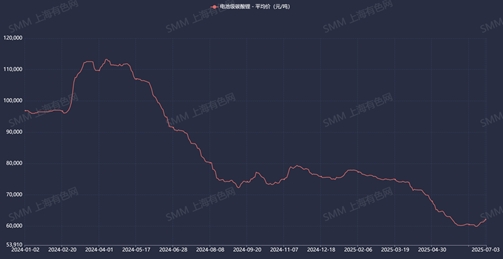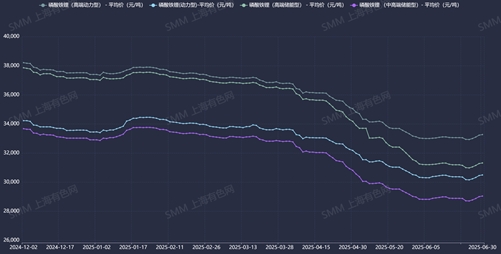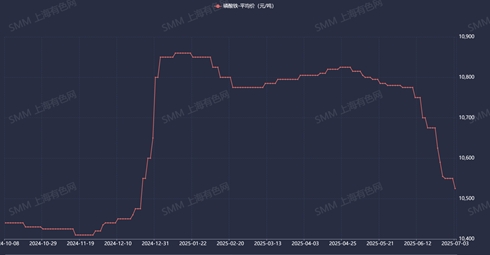






》View SMM cobalt and lithium product quotes, data, and market analysis
》Subscribe to view historical spot price trends of SMM cobalt and lithium products
Major battery cell manufacturers launch tenders – will LFP prices continue to fall in H2?
LFP prices primarily consist of two components: bundled processing fees (also known as valuation in the industry) + lithium carbonate price × settlement discount, with the bundled processing fees already incorporating raw material iron phosphate costs and processing expenses.
In pricing negotiations, upstream and downstream parties primarily focus on these two aspects, though commercial terms like payment periods are also considered. Generally, once bundled processing fees are agreed, they remain unchanged for monthly or quarterly execution cycles unless unexpected fluctuations occur in iron phosphate raw material prices. Therefore,LFP prices mainly fluctuate in line with lithium carbonate prices.
Starting from early April this year, lithium carbonate prices have experienced sustained and significant declines, gradually falling below the market's perceived "bottom-buying threshold."


[Source: SMM battery-grade lithium carbonate average price]
Closely correlated with lithium carbonate prices, LFP prices inevitably followed a sharp downward trajectory during these three months.
As of now,they have accumulated an average decline of over 3,000 yuan/mt, with May seeing the largest single-month drop (-5.3%), while April (-2.3%) and June (-2.7%) showed relatively smaller declines.

[Source: SMM LFP average price]
How will LFP prices evolve in H2? Analysis of raw material prices, processing fee trends, and downstream demand suggests a generally stable but weakening trajectory. The price floor depends on lithium carbonate price movements and processing fee trends.
"Iron phosphate price hikes successfully drove Q1 2025 processing fee increases"
Most companies finalized their 2025 processing fees before March,with overall increases ranging from 500-3,000 yuan/mt.The primary driver was the sharp rise in iron phosphate prices since December 2024. Continuing with original bundled processing feeswould have exacerbated losses for LFP material manufacturers, threatening normal operations.Meanwhile, downstream battery cell manufacturers raised processing fees to manage market volatility and stabilize supply chains. Post-adjustment,Q2 processing fees remained generally stable.
However,material manufacturers' pursuit of further price increases persists– despite prior adjustments, they continue negotiating additional hikes with battery cell manufacturers. However, market dynamics shifted in late April, with demand growth for iron phosphate slowing down. To secure orders, iron phosphate plants flooded the market with low prices, driving the average price of iron phosphate into a downward trend. Material producers, which previously maintained strong reluctance to budge on prices, lost a critical bargaining premise—rising iron phosphate prices. Despite active attempts to negotiate price hikes with battery cell manufacturers from April to June, material producers failed to achieve their targets.

[Source: SMM Iron Phosphate Average Price]
Hopes for further increases in LFP processing fees may prove unfounded.
In June, a major battery cell manufacturer launched tenders for LFP materials for H2. As anticipated, material producers quoting higher prices mostly lost the bids, while successful bidders generally offered lower prices. Excluding long-term agreement suppliers exempt from bidding, approximately four suppliers secured initial tenders, with unsuccessful bidders entering subsequent negotiations with the battery cell manufacturer individually.
Based on current information, this tender signals three developments:
The outlook for a significant rebound in lithium carbonate prices in H2 remains unclear.
Another key factor influencing LFP prices is the price of lithium carbonate. SMM believes that the growth rate of overall end-use demand will gradually slow down in H2 2025. Currently, there is no unexpected increase in demand, and when transmitted to the monthly production of LFP, the growth rate appears mediocre. The recent monthly production growth rate of LFP has also remained basically within 5%, approaching the growth rate of ternary cathode material. Therefore, the possibility of an improvement in the supply-demand pattern of lithium carbonate in H2 remains unclear, and it is difficult for its price to reverse the trend against the market.
Taking all the above points into consideration, the price war for processing fees is intensifying. Along with the difficulty in reversing the trend of lithium carbonate prices, there is a high possibility that LFP prices will continue to operate at a low level in H2. In this situation, material factories that lack the funds to support normal operations will face the risk of exiting the market, being acquired, or becoming toll processors.
SMM New Energy Research Team
Wang Cong 021-51666838
Ma Rui 021-51595780
Feng Disheng 021-51666714
Zhou Zhicheng 021-51666711
Wang Zihan 021-51666914
Lv Yanlin 021-20707875
Zhang Haohan 021-51666752
Wang Jie 021-51595902
Xu Yang 021-51666760
Chen Bolin 021-51666836
For queries, please contact Lemon Zhao at lemonzhao@smm.cn
For more information on how to access our research reports, please email service.en@smm.cn